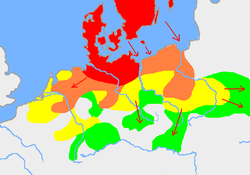
Back Агот бызшәа Abkhazian Goties Afrikaans Idioma gotico AN Gotisc sprǣc ANG اللغة القوطية Arabic قوطى ARZ Idioma góticu AST Qot dili Azerbaijani Gotische Sproch BAR Guotu kalba BAT-SMG
| Gothic | |
|---|---|
| Region | Oium, Dacia, Pannonia, Dalmatia, Italy, Gallia Narbonensis, Gallia Aquitania, Hispania, Crimea, North Caucasus |
| Era | attested 3rd–10th century; related dialects survived until 18th century in Crimea |
| Dialects |
|
| Gothic alphabet | |
| Language codes | |
| ISO 639-2 | got |
| ISO 639-3 | got |
| Glottolog | goth1244 |
| Linguasphere | 52-ADA |

Gothic is an extinct East Germanic language that was spoken by the Goths. It is known primarily from the Codex Argenteus, a 6th-century copy of a 4th-century Bible translation, and is the only East Germanic language with a sizeable text corpus. All others, including Burgundian and Vandalic, are known, if at all, only from proper names that survived in historical accounts, and from loanwords in other, mainly Romance, languages.
As a Germanic language, Gothic is a part of the Indo-European language family. It is the earliest Germanic language that is attested in any sizable texts, but it lacks any modern descendants. The oldest documents in Gothic date back to the fourth century. The language was in decline by the mid-sixth century, partly because of the military defeat of the Goths at the hands of the Franks, the elimination of the Goths in Italy, and geographic isolation (in Spain, the Gothic language lost its last and probably already declining function as a church language when the Visigoths converted from Arianism to Nicene Christianity in 589).[4] The language survived as a domestic language in the Iberian Peninsula (modern-day Spain and Portugal) as late as the eighth century. Gothic-seeming terms are found in manuscripts subsequent to this date, but these may or may not belong to the same language.
A language known as Crimean Gothic survived in the lower Danube area and in isolated mountain regions in Crimea as late as the second half of the 18th century. Lacking certain sound changes characteristic of Gothic, however, Crimean Gothic cannot be a lineal descendant of the language attested in the Codex Argenteus.[5][6]
The existence of such early attested texts makes Gothic a language of considerable interest in comparative linguistics.
- ^ a b "Gothic". LINGUIST List. Archived from the original on 10 August 2016. Retrieved 18 November 2024.
- ^ Kinder, Hermann (1988), Penguin Atlas of World History, vol. I, London: Penguin, p. 108, ISBN 0-14-051054-0.
- ^ "Languages of the World: Germanic languages". The New Encyclopædia Britannica. Chicago, IL, United States: Encyclopædia Britannica, Inc. 1993. ISBN 0-85229-571-5.
- ^ Strategies of Distinction: Construction of Ethnic Communities, 300–800 (Transformation of the Roman World, vol. 2) by Walter Pohl, ISBN 90-04-10846-7 (pp. 119–121)
- ^ Stearns 1978, p. 118.
- ^ MacDonald Stearns, Das Krimgotische. In: Heinrich Beck (ed.), Germanische Rest- und Trümmersprachen, Berlin/New York 1989, p. 175–194, here the chapter Die Dialektzugehörigkeit des Krimgotischen on p. 181–185